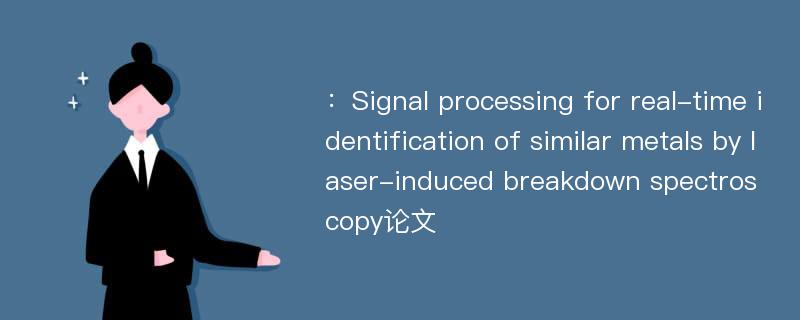
本文主要研究内容
作者(2019)在《Signal processing for real-time identification of similar metals by laser-induced breakdown spectroscopy》一文中研究指出:Laser-induced breakdown spectroscopy(LIBS) is regarded as a promising technique for realtime sorting of scrap metals due to its capability of fast multi-elemental and in-air analysis. This work reports a method for signal processing which ensures high accuracy and high speed during similar metal sorting by LIBS. Similar metals such as aluminum alloys or stainless steel are characterized by nearly the same constituent elements with slight variations in elemental concentration depending on metal type. In the proposed method, the original data matrix is substantially reduced for fast processing by selecting new input variables(spectral lines) using the information for the constituent elements of similar metals. Specifically, principal component analysis(PCA) of full-spectra LIBS data was performed and then, based on the loading plots, the input variables of greater significance were selected in the order of higher weights for each constituent element. The results for the classification test with aluminum alloy, copper alloy,stainless steel and cast steel showed that the classification accuracy of the proposed method was nearly the same as that of full-spectra PCA, but the computation time was reduced by a factor of 20 or more. The results demonstrated that incorporating the information for constituent elements can significantly accelerate classification speed without loss of accuracy.
Abstract
Laser-induced breakdown spectroscopy(LIBS) is regarded as a promising technique for realtime sorting of scrap metals due to its capability of fast multi-elemental and in-air analysis. This work reports a method for signal processing which ensures high accuracy and high speed during similar metal sorting by LIBS. Similar metals such as aluminum alloys or stainless steel are characterized by nearly the same constituent elements with slight variations in elemental concentration depending on metal type. In the proposed method, the original data matrix is substantially reduced for fast processing by selecting new input variables(spectral lines) using the information for the constituent elements of similar metals. Specifically, principal component analysis(PCA) of full-spectra LIBS data was performed and then, based on the loading plots, the input variables of greater significance were selected in the order of higher weights for each constituent element. The results for the classification test with aluminum alloy, copper alloy,stainless steel and cast steel showed that the classification accuracy of the proposed method was nearly the same as that of full-spectra PCA, but the computation time was reduced by a factor of 20 or more. The results demonstrated that incorporating the information for constituent elements can significantly accelerate classification speed without loss of accuracy.
论文参考文献
论文详细介绍
论文作者分别是来自Plasma Science and Technology的,发表于刊物Plasma Science and Technology2019年03期论文,是一篇关于,Plasma Science and Technology2019年03期论文的文章。本文可供学术参考使用,各位学者可以免费参考阅读下载,文章观点不代表本站观点,资料来自Plasma Science and Technology2019年03期论文网站,若本站收录的文献无意侵犯了您的著作版权,请联系我们删除。
